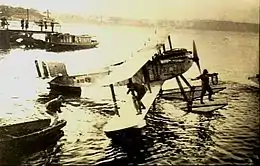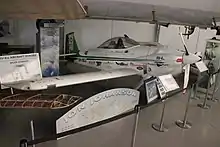The Oswald Watt Gold Medal is an Australian aviation award named for Oswald Watt (1878–1921), a decorated pilot in World War I.
It originated in 1921 after the death of Oswald Watt and is awarded for "A most brilliant performance in the air or the most notable contribution to aviation by an Australian or in Australia" by the Royal Federation of Aero Clubs of Australia. As it is awarded on merit it is not an annual award; between the award's creation and 1999 it had been awarded a total of 48 times. It was not awarded in the years 2000 - 2010.[1]
Recipients
The recipients are:[2]
- 1921 Francis Stewart Briggs – flew from Melbourne to Brisbane and from Melbourne to Perth
- 1922 Harry Turner Shaw – flew in a Farman Sport from Melbourne to Sydney and return in May 1922[3]
- 1923 No award

Fairey IIID floatplane flown by Ivor McIntyre during his circumnavigation of Australia in 1924
- 1924 Flight Lieutenant Ivor McIntyre – pilot of a Royal Australian Air Force (RAAF) Fairey IIID configured as a floatplane in the first circumnavigation of Australia by air; departing from RAAF Point Cook, Victoria on 6 April 1924 and landing on St. Kilda Beach 44 days later
- 1925 E. J. Jones – flew from Melbourne to Normanton in north-west Queensland and back to Melbourne
- 1926 Flight Lieutenant Ivor McIntyre – second award; pilot on a flight with Wing Commander (later Air Marshal) Richard Williams from RAAF Point Cook (now RAAF Williams) near Melbourne to the Solomon Islands and return
- 1927 Bert Hinkler – flew non-stop from London to Latvia as part of a business trip
- 1928 Bert Hinkler – second award; flew from England to Australia
- 1929 Sir Charles Kingsford Smith
- 1930 Sir Charles Kingsford Smith – second award
- 1931 Bert Hinkler – third award
- 1932 Bert Hinkler – fourth award
- 1933 Sir Charles Kingsford Smith – third award
- 1934 Sir Charles Kingsford Smith – fourth award
- 1935 Harry Frank (Jim) Broadbent
- 1936 Edgar Percival
- 1937 Dr. Clyde Fenton
- 1938 Don Bennett
- 1939-45 No awards
- 1946 Don Bennett – second award
- 1947 Squadron Leader Harold Brownlow Martin
- 1948-49 No awards
- 1950 Martin Warner – inadvertently set a British Empire altitude record for a glider of 23,500 feet (7,160 m) after he flew a Slingsby T.25 Gull 4 into a cloud and it was caught in an updraft[4]
- 1951 Patrick Gordon Taylor
- 1952 Squadron Leader P. G. Fisher
- 1953 Wing Commander Derek "Jell" Cuming
- 1954 Mervyn Waghorn
- 1955-56 No awards
- 1957 Sir Donald Anderson
- 1958 Squadron Leader D. W. Leckie
- 1959 A. E. Chadwick
- 1960 Brigadier Guy N. Moore
- 1961 No award
- 1962 Henry Millicer
- 1963 No award
- 1964 Edward Connellan – founder of Connellan Airways in 1939
- 1965 No award
- 1966 Harry Schneider
- 1967 Sir Hudson Fysh – founder of Qantas in 1921
- 1968 No award
- 1969 George Alfred (Peter) Lloyd
- 1970-72 No awards
- 1973 Sir Norman Brearley – founder of West Australian Airways in 1921
- 1974 Sir Lawrence Wackett
- 1975 Sir Reg Ansett – founder of Ansett in 1935
- 1976 Clive Canning – flew a Thorp T-18 that he had built himself from Melbourne to London and return; his arrival in London on 1 July completed the first Australia-England flight in a homebuilt aircraft[5][6]

Van's RV-4 built and flown by Jon Johanson, 1995 medal recipient; on display at the South Australian Aviation Museum

Astronaut Andy Thomas, 1998 medal recipient
- 1977 Horrie Miller – founder of MacRobertson Miller Airlines in 1927
- 1978 No award
- 1979 Bill Moyes
- 1980-82 No awards
- 1983 Dick Smith
- 1984-87 No awards
- 1988 Ian Honnery
- 1989-91 No awards
- 1992 Chris Dewhirst – the first person to fly a balloon over Mount Everest
- 1993 George "Scotty" Allan
- 1994 No award
- 1995 Jon Johanson – flew around the world in a Van's RV-4 two seat homebuilt aircraft that he had built himself, leaving Adelaide's Parafield Airport on 26 June 1995 and arriving back at Parafield on 4 September 1995[7]
- 1996 Shirley Adkins
- 1997 Bernie Sarroff
- 1998 Dr Andrew (Andy) Thomas – Australian-born NASA astronaut who was stationed on Mir Space Station for 141 days from January to June 1998; and was on Space Shuttle missions STS-77, STS-89/STS-91 (to and from Mir), STS-102 and STS-104
- 1999 Paul D. Scully-Power[8]
- 2000-2010 No awards
- 2011 Squadron Leader Paul Simmons[9]
- 2012 John W. Dickenson – "for a most notable contribution to Aviation by an Australian for his invention of the modern Hang Glider and making improvements in flight safety"
- 2013 Marj Davis Gillespie – "her voluntary contribution of sixteen years to the Royal Federation of Aero Clubs of Australia, the Flying Training Industry and General Aviation"
- 2014 Air Chief Marshal Sir Angus Houston – awarded for his work as head of the Joint Agency Coordination Centre, set up to oversee the search for Malaysia Airlines Flight 370; and as Australia's Special Envoy to Ukraine after the crash in Ukraine of Malaysia Airlines Flight 17
- 2015 no award
- 2016 George Alfred (Peter) Lloyd – second award; "for continued and valuable service to the Aviation Industry and in particular the safety of aviation"
- 2017-2018 no awards
See also
References
- ↑ "Awards". Royal Federation of Aero Clubs of Australia. Retrieved 31 August 2015.
- ↑ Oswald Watt Gold Medal winners list, Royal Federation of Aero Clubs of Australia. Retrieved 9 October 2019
- ↑ "Flying Helmet - Major H.T Shaw, RFC & RAF, circa 1918". museumvictoria.com.au. Museum Victoria. Archived from the original on March 3, 2014. Retrieved 27 February 2014.
- ↑ "Sydney Soaring Club's Slingsby Gull 4, c. 1948 - airframe parts" (PDF). Australian Gliding Museum. Retrieved 10 October 2019.
- ↑ Johanson (1997) p.59
- ↑ "World Aviation in 1976". century-of-flight.net. Retrieved 27 February 2014.
- ↑ "VAN'S RV-4 Registration No. VH-NOJ", information placard, South Australian Aviation Museum
- ↑ CASA media release – CASA chairman honoured
- ↑ Squadron Leader Simmons Wins Oswald Watt Medal retrieved 8 September 2012
- AFC website list of Oswald Watts Gold Medal recipients retrieved 2007-08-21.
- Johanson, Jon (1997). Aiming High: The Little Australian Built to Fly the World. Kent Town, SA: Wakefield Press. ISBN 1 86254 424 7.
- Royal Federation of Aero Clubs of Australia
This article is issued from Wikipedia. The text is licensed under Creative Commons - Attribution - Sharealike. Additional terms may apply for the media files.